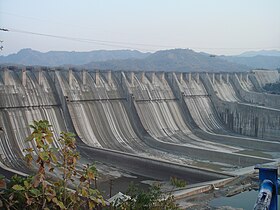Narmada Dam Project
The Narmada Dam Project is a project involving the construction of a series of large hydroelectric dams on the Narmada River in India. The project was first conceived of in the 1940s by the country's first prime minister, Jawaharlal Nehru. The project only took form in 1979 as part of a development scheme to increase irrigation and produce hydroelectricity.
Of the thirty large dams planned on river Narmada, Sardar Sarovar Project (SSP) is the largest multipurpose project involved in the construction. With a proposed height of 136.5 m, it's also high on discord between the planners and the Narmada Bachao Andolan. The multi-purpose project will irrigate more than 18,000 square kilometres, most of it in drought prone areas like Kutch and Saurashtra. Critics maintain that its negative environmental impact outweights its benefits.
Suggested benefits of the Sardar Sarovar dam
The expected benefits of the dam as listed in the Judgement of Supreme Court of India are:
- Irrigation: 17,920 km² of land spread over 12 districts, 62 talukas and 3393 villages (75% of which is drought-prone areas) in Gujarat and 730 km² in the arid areas of Barmer and Jalore districts of Rajasthan.
Height issues
- In February 1999, the Supreme Court of India gave the go ahead for the dam's height to be raised to 88 metres from the initial 80.
- In October 2000 again, in a 2 to 1 majority judgement in the Supreme Court, the government was allowed to construct the dam up to 90 metres.
- In May 2002, the Narmada Control Authority approved increasing the height of the dam by another five metres.
- In March 2004, the Authority allowed another raise, this time to 110 metres.
- In March 2006, the Narmada Control Authority gave clearance for the height of the dam to increased from 110.64 metres to 121.92. This came after the Supreme Court of India had refused to stay the height of the dam again in 2003.
Controversy
Protest
The Narmada dam is India's most controversial dam project and its environmental impact and net costs and benefits are widely debated. The World Bank was a initially a funder of the SSP, but withdrew in 1990. The Narmada Dam has been the centre of controversy and protest since the late 1980s. One such protest takes center stage in Spanner Films's documentary Drowned Out (2002), which follows one tribal family who decide to stay at home and drown rather than make way for the Narmada Dam. An earlier documentary film is called A Narmada Diary (1995) by Anand Patwardhan and Simantini Dhuru. The efforts of NBA to seek social and environmental justice for those most directly affected by the Sardar Sarover Dam construction feature prominently in this award winning film (Best Documentary 1996 Filmfare).[citation needed]
The figurehead of much of the protest is Medha Patkar, a leader of the "Narmada Bachao Andolan," the "Save Narmada Movement." The movement was cemented in 1989, and was awarded the Right Livelihood Award in 1991.[1]
Support for the protests also came from Indian author Arundhati Roy, who wrote the extended essay "The Greater Common Good" in protest of the Narmada Dam Project;[2] the essay was reprinted in her book The Cost of Living. In that essay, Roy states:
Big Dams are to a Nation's 'Development' what Nuclear Bombs are to its Military Arsenal. They're both weapons of mass destruction. They're both weapons Governments use to control their own people. Both Twentieth Century emblems that mark a point in time when human intelligence has outstripped its own instinct for survival. They're both malignant indications of civilisation turning upon itself. They represent the severing of the link, not just the link - the understanding - between human beings and the planet they live on. They scramble the intelligence that connects eggs to hens, milk to cows, food to forests, water to rivers, air to life and the earth to human existence.
The Supreme Court decision
Despite popular protest, the Supreme Court gave clearance for the height to be increased to 121.92 m (400 ft), but in the same judgment Mr. Justice Bharucha gave directions to Madhya Pradesh and Maharashtra (the Grievance Redressal Authorities of Gujarat) that before further construction begins, they should certify (after inspection) that all those displaced by the raise in height of 5 metres have already been satisfactorily rehabilitated, and also that suitable vacant land for rehabilitating them is already in the possession of the respective States. This process shall be repeated for every successive 5-metre increase in height.

No comments:
Post a Comment